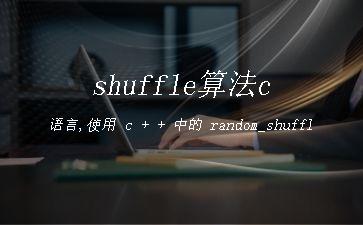在 Visual c + + 中使用 random_shuffle STL 函数
04/24/2020
本文内容
本文介绍如何使用 random_shuffle Visual c + + 中的标准模板库(STL)函数。
原始产品版本: Visual c + +
原始 KB 数: 156994
必需标头
Prototype
template inline
void random_shuffle(RandomAccessIterator first,
RandomAccessIterator last,
Predicate pred)
备注
原型中的类/参数名称与头文件中的原始版本不匹配。 已对其进行修改以提高可读性。
说明
random_shuffle算法 shuffles 序列中的元素(first。最后)的随机顺序。
谓词版本使用 pred 函数生成要交换的元素的索引。 Pred 必须是一个 function 对象,该对象采用参数n ,并返回0到(n-1)范围内的整数随机数字。
用于执行交换的谓词版本 random_shuffle operator= 。
示例代码
//
// Compile options needed: /GX
// random_shuffle.cpp: Illustrates how to use the predicate version
// of the random_shuffle function.
// Functions:
// random_shuffle: Shuffle the elements in a random order.
// Rand: Given n, generates an integral random number in the
// in the range 0 – (n – 1).
// of Microsoft Product Support Services,
// Software Core Developer Support.
// Copyright (c) 1996 Microsoft Corporation. All rights reserved.
//
// disable warning C4786: symbol greater than 255 character,
// okay to ignore
#pragma warning(disable: 4786)
#include
#include
#include
#include
using namespace std;
// return an integral random number in the range 0 – (n – 1)
int Rand(int n)
{
return rand() % n ;
}
void main()
{
const int VECTOR_SIZE = 8 ;
// Define a template class vector of int
typedef vector > IntVector;
//Define an iterator for template class vector of strings
typedef IntVector::iterator IntVectorIt;
IntVector Numbers(VECTOR_SIZE);
IntVectorIt start, end, it;
// Initialize vector Numbers
Numbers[0] = 4;
Numbers[1] = 10;
Numbers[2] = 70;
Numbers[3] = 30;
Numbers[4] = 10;
Numbers[5] = 69;
Numbers[6] = 96;
Numbers[7] = 100;
start = Numbers.begin(); // location of first
// element of Numbers
end = Numbers.end(); // one past the location
// last element of Numbers
cout << “Before calling random_shuffle:\n” << endl;
// print content of Numbers
cout << “Numbers { “;
for(it = start; it != end; it++)
cout << *it << ” “;
cout << ” }\n” << endl;
// shuffle the elements in a random order.
// the pointer_to_unary_function adapter converts a function to a
// function object.
random_shuffle(start, end, pointer_to_unary_function(Rand));
cout << “After calling random_shuffle:\n” << endl;
cout << “Numbers { “;
for(it = start; it != end; it++)
cout << *it << ” “;
cout << ” }\n” << endl;
}
程序输出:
Before calling random_shuffle
Numbers { 4 10 70 30 10 69 96 100 }
After calling random_shuffle
Numbers { 10 30 4 70 96 100 69 10 }
参考
有关函数的详细信息 random_shuffle ,请访问RANDOM_SHUFFLE (STL 示例)。
今天的文章shuffle算法c语言,使用 c + + 中的 random_shuffle 函数 – Visual C++ | Microsoft Docs分享到此就结束了,感谢您的阅读,如果确实帮到您,您可以动动手指转发给其他人。
版权声明:本文内容由互联网用户自发贡献,该文观点仅代表作者本人。本站仅提供信息存储空间服务,不拥有所有权,不承担相关法律责任。如发现本站有涉嫌侵权/违法违规的内容, 请发送邮件至 举报,一经查实,本站将立刻删除。
如需转载请保留出处:https://bianchenghao.cn/32782.html

